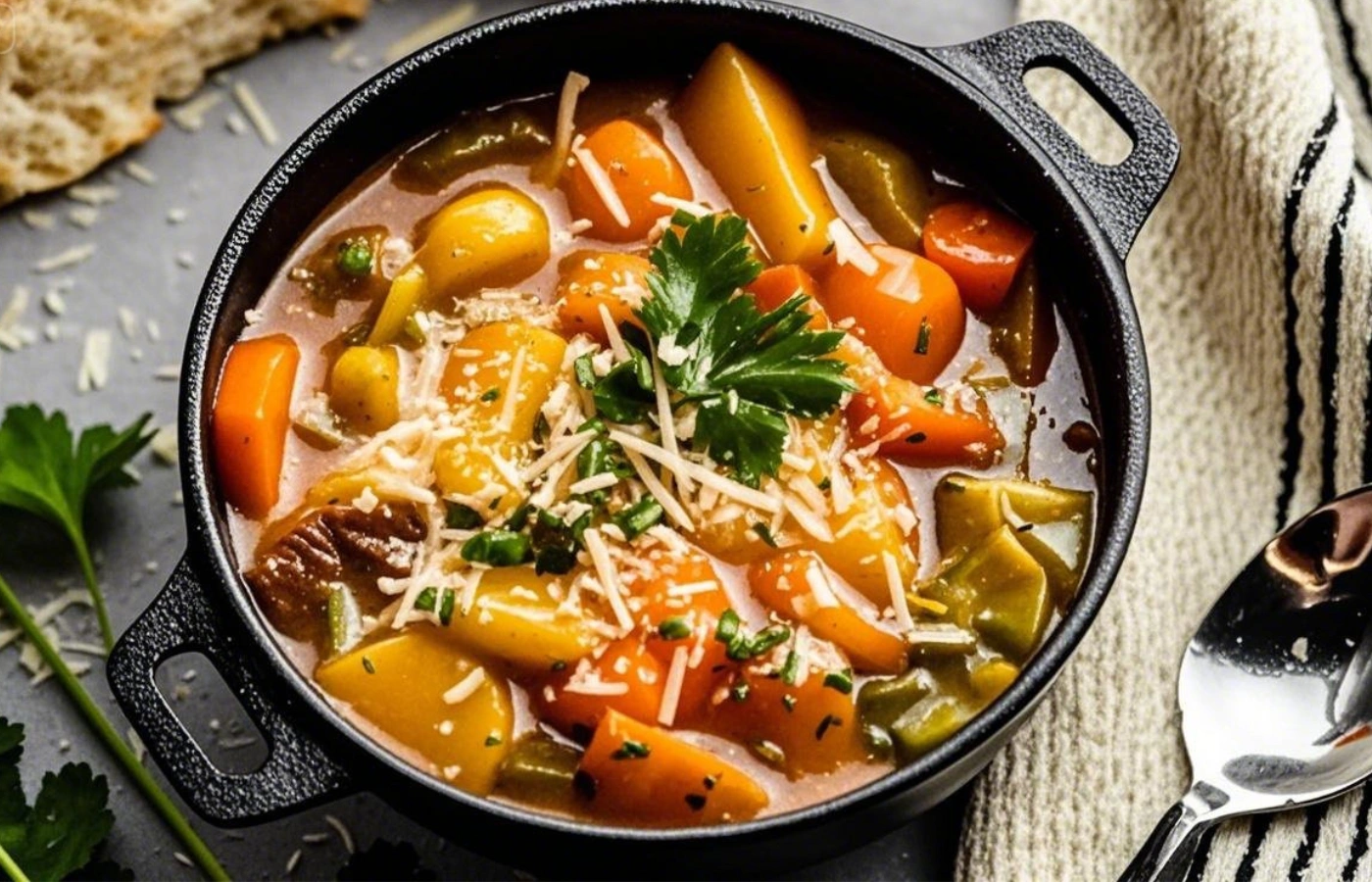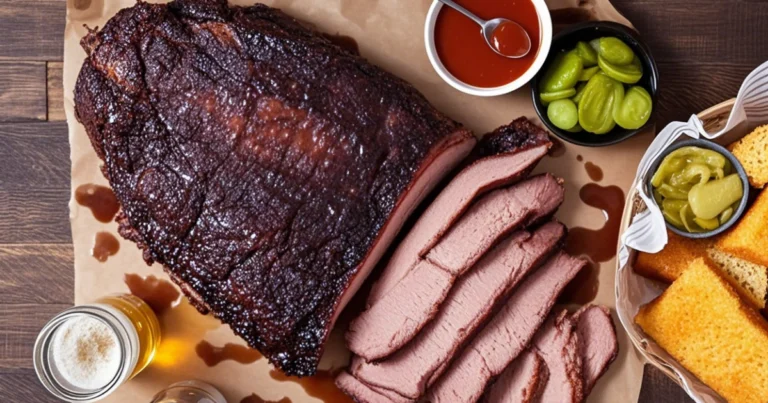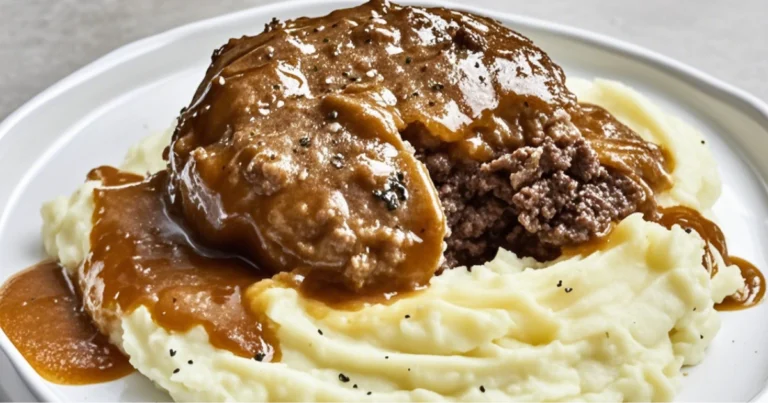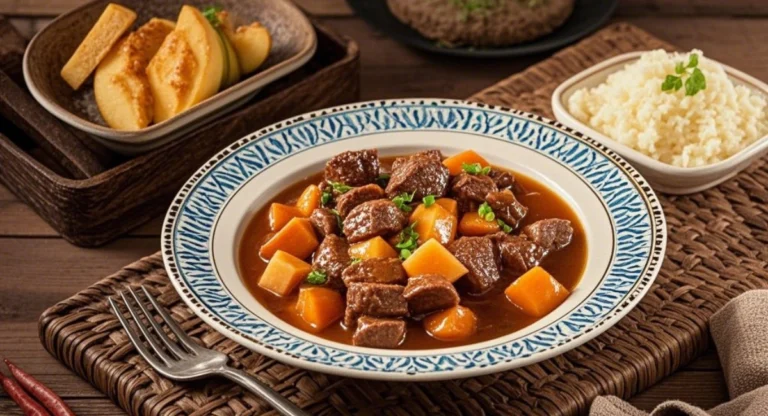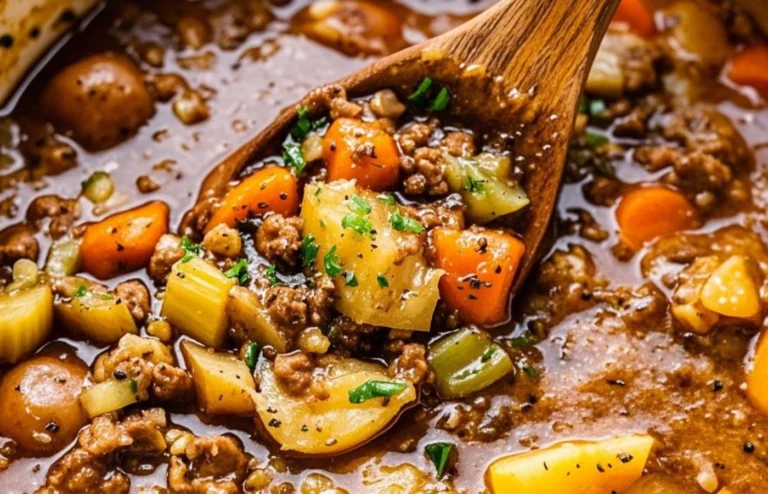Mississippi Beef Stew – A Comforting, Flavor-Packed Classic You’ll Love
Table of Contents
The gentle simmer of a pot on the stove, steam rising to fog kitchen windows as rain taps against the glass. Few things speak to the soul quite like a hearty beef stew bubbling away on a cool afternoon. Mississippi Beef Stew isn’t just a meal—it’s a warm embrace in a bowl, carrying with it generations of Southern comfort and hospitality. This isn’t merely food; it’s a homecoming, a tradition, a story told through rich broth and tender beef that falls apart at the touch of a fork.
I still remember my grandmother standing over her cast iron Dutch oven, wooden spoon in hand, adding a pinch of this and a dash of that—never measuring, always knowing. The kitchen would fill with aromas so inviting that the entire family would find excuses to wander in. “Just checking if you need help,” we’d say, hoping for a taste. That first spoonful of her Mississippi Beef Stew—rich with tender beef, sweet onions, and that distinctive Southern flavor profile—always felt like being wrapped in your favorite quilt.
Today, I’m sharing my version of this cherished recipe. It honors those traditional Southern roots while incorporating a few special techniques that take it from delicious to unforgettable. This isn’t just any beef stew—it’s Mississippi Beef Stew, with its characteristic depth of flavor that sets it apart from its Northern counterparts.
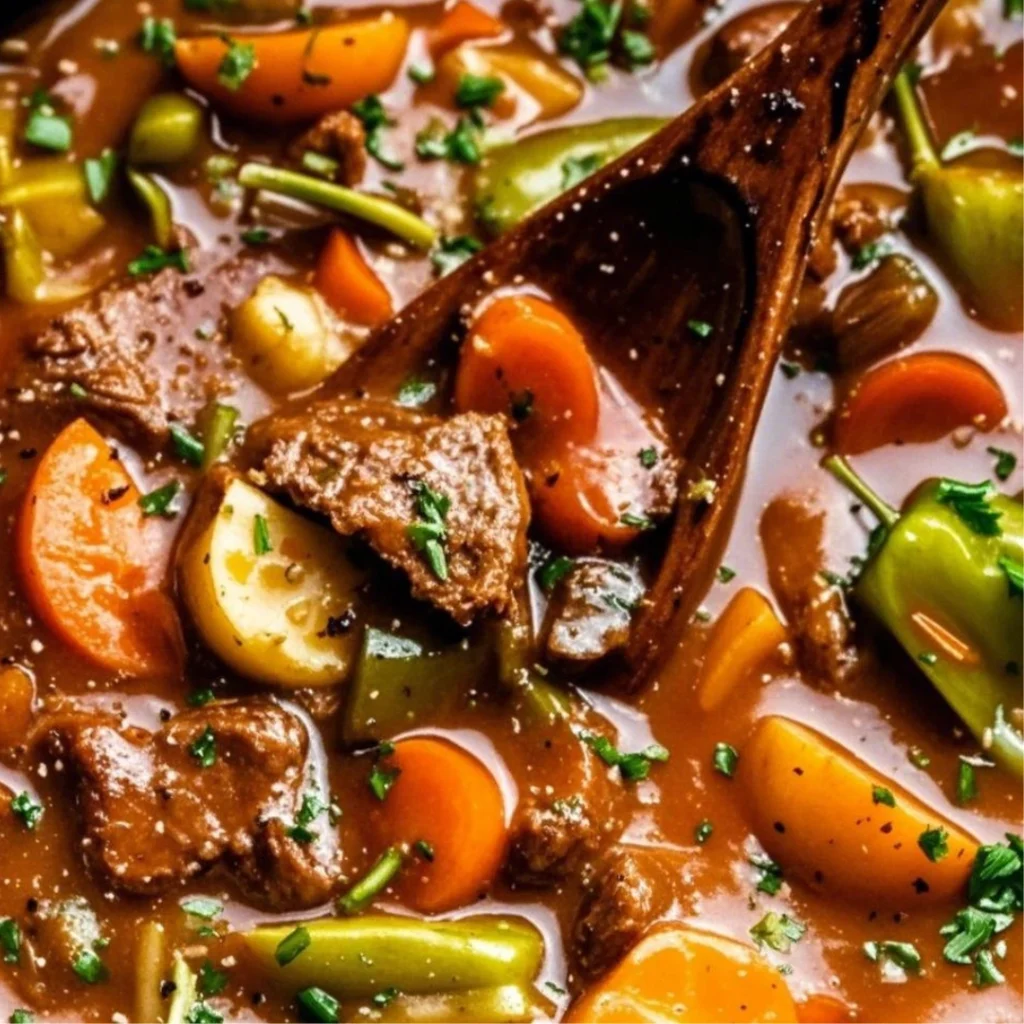
What Makes Mississippi Beef Stew Special
Mississippi Beef Stew distinguishes itself through its rich, slightly tangy flavor profile and supreme tenderness. Unlike traditional beef stews, Mississippi-style incorporates elements that might surprise you—a touch of vinegar to balance the richness, a hint of sweetness to round out the savory elements, and cooking techniques that ensure every bite of beef melts in your mouth.
This stew doesn’t rush. It takes its time, just like conversations on Southern porches that stretch lazily into the evening. Each ingredient contributes to the symphony of flavors—the caramelized onions provide sweetness, tomatoes lend acidity, and herbs add aromatic complexity. The result is a stew with remarkable depth that improves with each hour it simmers and tastes even better the next day.
Ingredients For Mississippi Beef Stew
For the Stew Base:
- 3 pounds beef chuck roast, cut into 1.5-inch cubes
- 2 tablespoons vegetable oil
- 2 tablespoons butter
- 1 large yellow onion, diced
- 3 medium carrots, peeled and cut into 1-inch pieces
- 2 celery stalks, diced
- 4 cloves garlic, minced
- 2 tablespoons tomato paste
- 1/4 cup all-purpose flour
- 1 cup dry red wine (or additional beef broth)
- 4 cups beef broth
- 1 can (14.5 oz) diced tomatoes
- 2 tablespoons Worcestershire sauce
- 1 tablespoon apple cider vinegar
- 2 bay leaves
- 2 sprigs fresh thyme (or 1 teaspoon dried)
- 1 sprig fresh rosemary (or 1/2 teaspoon dried)
- 1 tablespoon brown sugar
- 1 teaspoon paprika
- 1/2 teaspoon ground black pepper
- Salt to taste
For the Vegetable Finish:
- 1 pound baby potatoes, halved
- 8 oz mushrooms, quartered
- 1 cup frozen peas
- 2 tablespoons fresh parsley, chopped

Steps for Mississippi Beef Stew
Preparing the Beef
- Begin by thoroughly patting the beef chunks dry with paper towels. This is crucial for achieving a good sear, which develops the deep flavor foundation of the stew. Season generously with salt and pepper.
- Heat the vegetable oil in a large Dutch oven or heavy-bottomed pot over medium-high heat until it’s shimmering but not smoking.
- Working in batches to avoid overcrowding (which would steam rather than sear the meat), add the beef cubes to the hot oil. Allow them to develop a rich brown crust on all sides, about 3-4 minutes per side. Transfer the seared beef to a plate and set aside.
- Once all beef is seared, reduce heat to medium and add the butter to the pot. When melted, add the diced onions and a pinch of salt. Cook until they begin to soften and turn translucent, about 5 minutes.
Building the Flavor Base
- Add the carrots and celery to the pot with the onions. Cook for another 5 minutes, stirring occasionally, until the vegetables begin to soften.
- Add the minced garlic and cook for just 30 seconds until fragrant, being careful not to burn it.
- Stir in the tomato paste and cook for 2 minutes, allowing it to caramelize slightly, which deepens the flavor of the stew significantly.
- Sprinkle the flour over the vegetable mixture and stir continuously for 2 minutes to cook out the raw flour taste. This will help thicken your stew to the perfect consistency.
- Slowly pour in the red wine (or additional broth), scraping the bottom of the pot with a wooden spoon to release all the flavorful browned bits—this is where much of your stew’s character comes from.
The Slow Simmer
- Return the seared beef to the pot along with any accumulated juices. Add the beef broth, diced tomatoes, Worcestershire sauce, apple cider vinegar, bay leaves, thyme, rosemary, brown sugar, paprika, and black pepper.
- Bring the mixture to a gentle boil, then reduce the heat to maintain a low simmer. Cover partially with a lid, allowing some steam to escape.
- Let the stew simmer for 1.5 hours, stirring occasionally to prevent sticking.
- After 1.5 hours, add the halved baby potatoes and quartered mushrooms. Continue to simmer for another 30-45 minutes, or until both the beef and potatoes are fork-tender.
- In the last 5 minutes of cooking, stir in the frozen peas, allowing them to heat through while maintaining their bright green color.
- Remove the bay leaves, thyme sprigs, and rosemary sprig. Taste and adjust seasoning with salt and pepper as needed.
- Serve hot, garnished with freshly chopped parsley.

Variations of Mississippi Beef Stew
Southern Smokehouse Version
Add 1 teaspoon of liquid smoke to the broth and replace the paprika with smoked paprika. This gives the stew a delicious smoky flavor reminiscent of traditional Southern smokehouse cooking.
Spicy Mississippi Stew
Incorporate 1-2 diced jalapeños with the onions and add 1/4 teaspoon of cayenne pepper to the spice mix. For an extra kick, serve with hot sauce on the side.
Creole-Inspired Mississippi Stew
Add 1 diced green bell pepper with the onions and incorporate 1 tablespoon of Creole seasoning. Serve the stew over cooked white rice for a heartier meal with New Orleans flair.
Root Vegetable Harvest Version
In addition to the standard vegetables, add 1 diced sweet potato, 1 diced parsnip, and 1/2 cup of butternut squash cubes with the potatoes. This creates a more colorful stew with additional sweetness and nutritional value.
Tips for Perfect Mississippi Beef Stew
Choosing the Right Cut of Beef
Chuck roast is ideal for this stew because it has enough fat marbling to keep the meat moist and tender during the long cooking process. Avoid leaner cuts like sirloin, which can become tough. If chuck isn’t available, brisket or short ribs are good alternatives.
The Secret to Tender Meat
The key to melt-in-your-mouth beef lies in two techniques: a proper initial sear and the slow simmer. Never rush the browning process—those extra minutes developing a crust on each piece of beef will pay dividends in flavor. Likewise, resist the urge to boil the stew; a gentle simmer allows the collagen in the meat to break down slowly without toughening the proteins.
Make-Ahead Magic
This stew actually improves with time as the flavors meld and deepen. Consider making it a day in advance and refrigerating overnight. Not only does this enhance the flavor, but it also allows you to easily remove any solidified fat from the surface before reheating.
Storage and Freezing
Mississippi Beef Stew will keep in the refrigerator for up to 4 days. For freezing, cool the stew completely, then portion into airtight containers, leaving some space for expansion. It freezes beautifully for up to 3 months. Thaw overnight in the refrigerator before reheating gently on the stovetop.
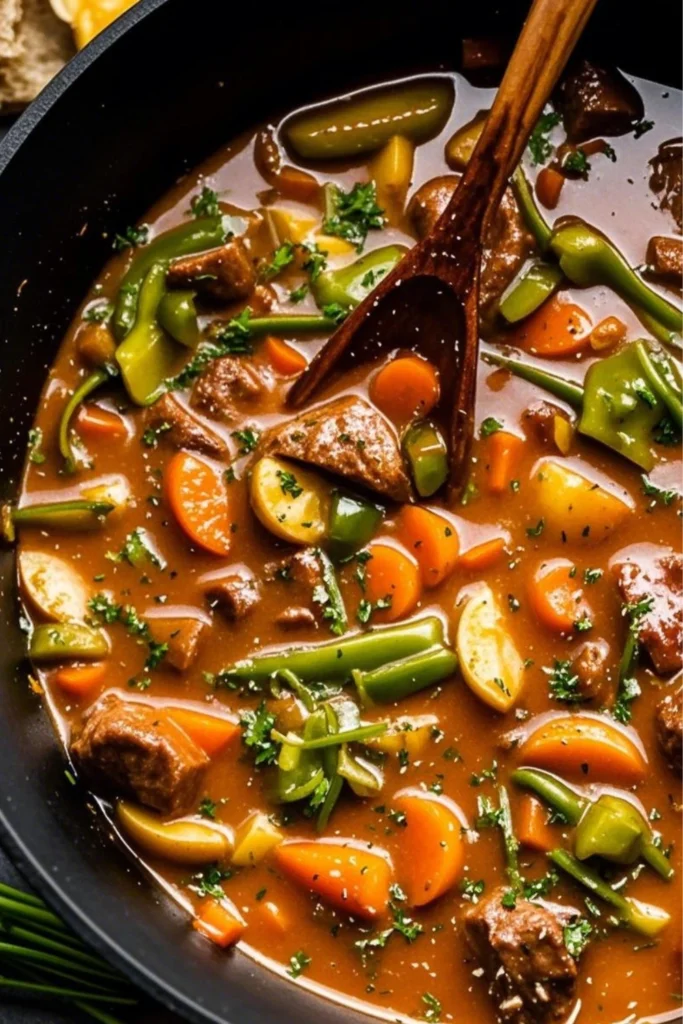
Conclusion
Mississippi Beef Stew embodies the heart of Southern cooking—taking simple ingredients and, through patience and care, transforming them into something greater than the sum of their parts. This isn’t fast food; it’s slow food in the best sense, a dish that rewards the cook who understands that excellence cannot be rushed.
As you ladle this rich, aromatic stew into bowls for your family or friends, you’re not just serving a meal—you’re continuing a tradition that stretches back through generations of Southern kitchens. The conversation may slow as everyone takes their first bite, savoring the tender beef, the velvety broth, and the perfectly cooked vegetables.
In our fast-paced world, dishes like Mississippi Beef Stew remind us to slow down, to appreciate the process as much as the result. They connect us to our culinary heritage and to each other. So set the table, break out some crusty bread for sopping up that magnificent gravy, and enjoy not just the flavors of this remarkable stew, but the moments it creates around your table.
FAQs
Can I make Mississippi Beef Stew in a slow cooker?
Yes, you can adapt this recipe for a slow cooker. Follow the steps for searing the meat and sautéing the vegetables, then transfer everything to your slow cooker. Cook on low for 7-8 hours or on high for 4-5 hours. Add the potatoes and mushrooms during the last 1-2 hours of cooking, and the peas in the final 15 minutes.
What’s the best way to thicken the stew if it’s too thin?
If your stew needs additional thickening, make a slurry by combining 1 tablespoon of cornstarch with 2 tablespoons of cold water. Stir this mixture into the simmering stew and cook for an additional 5-10 minutes until it reaches your desired consistency.
Can I use a different type of meat?
While beef chuck creates the most authentic Mississippi Beef Stew, you can substitute pork shoulder for a different flavor profile. The cooking method would remain the same, though the flavor will naturally be different.
My beef is tough even after the recommended cooking time. What went wrong?
Paradoxically, if your beef is tough after the full cooking time, it likely needs more time, not less. Tough stew meat usually indicates that the collagen hasn’t had sufficient time to break down into gelatin. Continue simmering gently until the meat becomes tender.
What can I serve with Mississippi Beef Stew?
Traditional accompaniments include cornbread, buttermilk biscuits, or crusty French bread for sopping up the gravy. A simple green salad with a vinaigrette dressing provides a nice contrast to the richness of the stew.
Can I omit the wine from the recipe?
Absolutely. While wine adds depth of flavor and acidity, you can substitute an equal amount of additional beef broth plus 1 tablespoon of additional vinegar to maintain the flavor balance.
How can I make this recipe gluten-free?
Substitute the all-purpose flour with a gluten-free flour blend or cornstarch for thickening. Also, ensure your Worcestershire sauce is gluten-free, as some brands contain wheat-based ingredients.

